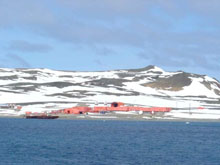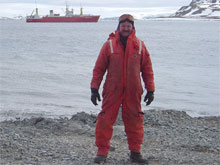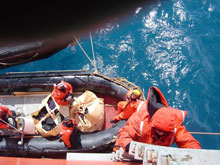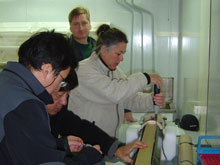The King Sejong Station on King George Island as seen from the ship. Click image for larger view and image credit.
King George Island, Antarctic
December 6, 2005
William Hanshumaker
Oregon State University
Public Marine Education Specialist
Extension Sea Grant Faculty
Weather: Partly-sunny with temperatures hovering around -2C(28F),
Winds: 15 knots with wind gusts up to 25 with choppy seas
We woke early today, already packed for our transfer from King Sejong Station on King George Island to the Russian icebreaker Yuzhmorgeologiya. We were told last night that this would happen at 10:00 a.m., but alas, this was not to be. The captain decided to delay until the seas subsided. We spent the morning checking the web and sending out emails while watching as the ship slowly approach. We knew this would be our last opportunity until next week when we returned to Chile. These Web postings from sea are via a satellite phone, which is very expensive.
Ready to board the Zodiac for transfer to the Yuzhmorgeologiya. Click image for larger view and image credit.
Our transfer was postponed twice, until we were finally told to gather at the quay at 1:00. After goodbyes and last minute pictures with our new friends from the South Korean base, we once again donned our Mustang suits to be ferried out to the icebreaker.
As we steadily approach the Yuzhmorgeologiya, her large size became more apparent. At 300 feet in length, she is larger than any NOAA research vessel, and the distance from her deck to the sea level appeared somewhat daunting. For a ship this size, personnel transfers are typically accomplished directly from a dock via a gangplank, but this could not be done because of the shallow water depth adjacent to King Sejong Station's dock. Instead, the Yuzhmorgeologiya's crew lowered a rope ladder over the side that we carefully ascended one at a time. Though the larger research equipment had been previously shipped and stowed, all our personal gear had to be raised by crane and canvas cradle.
Sara Heimlich carefully working her way up the rope ladder. Click image for larger view and image credit.
Ascending this rope ladder was not easy. Though there are slats of wood to step on, getting from a rolling Zodiac and up vertical ladder requires care and coordination. Fortunately, everyone was able to accomplish this without mishap and we set off on a new stage of our adventure.
The first step was to assure that all of the previously shipped equipment had arrived undamaged. Searching through the Yuzhmorgeologiya's hold, all of the NOAA labeled crates shipped out last September were located. As a research vessel, Yuzhmorgeologiya has dedicated space for a variety of laboratories. We moved the hydrophones into the Geological Lab where Haru and Bob began their assembly. It is necessary to ship the hydrophone unit in parts in order to test each component before deployment. Given the time, effort and cost of this endeavor, everything needs to be checked to assure its successful operation.
Assembling the hydrophone in the Geological Lab on the Yuzhmorgeologiya. Click image for larger view and image credit.
The first hydrophone location requires about four hours of ship time. Every minute is needed aboard for preparation. Haru is testing and assembling in the Geological Lab, while Bob is on deck supervising the layout of the hydrophone's mooring equipment. This consists of a 37-inch syntactic form float with a flashing light, connected to chain and 3/4 inch nylon rope to the "Haruphone". The Haruphone is autonomous, and needs to be recovered in order to retrieve its data. This specially designed hydrophone is deployed at a 400-meter depth and attached a 5/16-inch mooring line, whose length depends on the depth of the ocean bottom at that location. This in turned is shacked to the acoustic release. The acoustic release frees the hydrophone from the anchor when the recovery vessel broadcasts a coded frequency of sound underwater. The acoustic release is connected by wire and chain to an 850-pound railroad wheel, which serves as the anchor. We hope to recover all of the hydrophones next year.
Because each hydrophone is in a different depth, each mooring is unique. To avoid error, the mooring diagram is displayed prominently on deck, and is referred to continually. The process of deploying the first hydrophone began at 2000 hours, and required more than 2 hours for completion. We fell into our bunks exhausted from a full day of activity, but satisfied with the completion of our first successful deployment.Sounds of the Southern Ocean will be sending several reports from Dec 3 - 13. Please check back for additional logs from this expedition.
Sign up for the Ocean Explorer E-mail Update List.
















